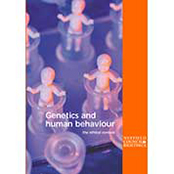the ethical context
Why this Working Party is important………………………………………………………………………. 5
Defining the normal range of behavioural characteristics………………………………………… 7
The scope of research in behavioural genetics ………………………………………………………… 8
The structure of the Report……………………………………………………………………………………. 8
Chapter 2: The historical context………………………………………………………………………….. 11
The impact of eugenic thought on research into human behaviour ……………………….. 18
Psychology in the first half of the twentieth century …………………………………… 18
Psychology from the 1960s onwards……………………………………………………………. 20
Individual differences ………………………………………………………………….. 20
Evolutionary psychology………………………………………………………………. 21
Processes of development ……………………………………………………………. 21
Conclusion…………………………………………………………………………………………………………… 22
Section II: Scientific background
Chapter 3: Research in behavioural genetics …………………………………………………………. 25
Introduction………………………………………………………………………………………………………… 27
What is genetic variation?……………………………………………………………………………………. 29
What is meant by normal variation in human behaviour?……………………………………… 31
‘A gene for X’? ……………………………………………………………………………………………………. 32
Describing human behaviour ……………………………………………………………………………….. 35
Predicting human behaviour from genetic information…………………………………………. 35
Conclusion…………………………………………………………………………………………………………… 36
Chapter 4: Quantitative genetics: measuring heritability ………………………………………. 37
Introduction ………………………………………………………………………………………………………… 39
How is population variation examined using genetic studies?………………………………… 39
Genetic influences on variation…………………………………………………………………… 39
Environmental influences on variation ………………………………………………………… 41
Gene-environment correlation and interaction ……………………………………………. 41
Family, twin and adoption studies…………………………………………………………………………. 42
Family studies …………………………………………………………………………………………….. 42
Studies of twins………………………………………………………………………………………….. 42
Methods ……………………………………………………………………………………… 42
Interpretation of twin study findings……………………………………………. 43
Adoption studies………………………………………………………………………………………………….. 44
Current uses of quantitative genetic studies ………………………………………………………….. 45
Conclusion …………………………………………………………………………………………………………… 46
Chapter 5: Identifying genetic factors contributing to individual differences in behaviour. 47
Introduction ………………………………………………………………………………………………………… 49
Approaches to identifying susceptibility alleles……………………………………………………… 49
Linkage studies ………………………………………………………………………………………….. 50
Association studies …………………………………………………………………………………….. 51
Identification of alleles that influence behaviour ………………………………………… 52
Scaling up the analysis: new methods in genetics………………………………………… 52
Conclusion…………………………………………………………………………………………………………… 53
Chapter 6: Research in behaviour genetics involving animals ……………………………….. 55
Introduction ………………………………………………………………………………………………………… 57
How are animal models created?………………………………………………………………………….. 58
What are the benefits of using animals to study the genetics of human behaviour?.. 60
What are the problems with using animals to study the genetics of human behaviour? .. 61
Conclusion…………………………………………………………………………………………………………… 63
Part III: Reviews of the evidence
Chapter 7: Intelligence…………………………………………………………………………………………. 67
Background…………………………………………………………………………………………………………. 69
Trait definition and measurement ………………………………………………………………………… 69
Current findings: quantitative genetics …………………………………………………………………. 71
Current findings: molecular genetics …………………………………………………………………….. 73
Directions for future research ………………………………………………………………………………. 76
Chapter 8: Personality………………………………………………………………………………………….. 79
Background………………………………………………………………………………………………………….. 81
Trait definition and measurement ………………………………………………………………………… 81
Current findings: quantitative genetics …………………………………………………………………. 83
Current findings: molecular genetics …………………………………………………………………….. 84
Quantitative trait loci research……………………………………………………………………. 85
Current findings: research involving animals …………………………………………………………. 85
Future directions for research ………………………………………………………………………………. 86
Chapter 9: Antisocial behaviour……………………………………………………………………………. 87
Background…………………………………………………………………………………………………………. 89
Trait definition and measurement ………………………………………………………………………… 89
Current findings: quantitative genetics …………………………………………………………………. 91
Antisocial behaviour…………………………………………………………………………………… 91
Violence…………………………………………………………………………………………………….. 93
Sex differences…………………………………………………………………………………………… 94
Current findings: molecular genetics …………………………………………………………………….. 95
Current findings: research involving animals …………………………………………………………. 95
Future directions from research ……………………………………………………………………………. 96
Chapter 10: Sexual orientation …………………………………………………………………………….. 97
Background…………………………………………………………………………………………………………. 99
Trait measurement and definition ………………………………………………………………………… 99
Current findings: quantitative genetics ……………………………………………………………….. 100
Families ………………………………………………………………………………………………… 100
Twins and adopted siblings ………………………………………………………………………. 101
Male homosexuality ………………………………………………………………….. 101
Female homosexuality……………………………………………………………….. 102
Current findings: molecular genetics …………………………………………………………………… 102
Current findings: research involving animals ……………………………………………………….. 103
Current findings: other biological influences……………………………………………………….. 104
Critical assessment of the validity of this evidence…………………………………………………105
Evolutionary arguments against genetic influences on homosexuality ………………….. 106
Future directions for research …………………………………………………………………………….. 107
Chapter 11: Themes from the reviews of the evidence………………………………………… 109
Introduction ………………………………………………………………………………………………………. 111
The difficulty of defining and measuring traits ……………………………………………………. 111
Estimates of heritability ……………………………………………………………………………………… 111
The lack of replicated findings in molecular genetics …………………………………………… 112
Applications of current research findings…………………………………………………………….. 112
Reporting research in behavioural genetics…………………………………………………………. 113
Funding research in behavioural genetics……………………………………………………………. 114
Conclusion…………………………………………………………………………………………………………. 115
Part IV: Ethical, legal, social and policy issues
Chapter 12: Genetics, freedom and human dignity ……………………………………………… 119
The material self………………………………………………………………………………………………… 122
Determinism and fatalism…………………………………………………………………………………… 123
Freedom, possibility and rationality…………………………………………………………………….. 124
Eliminating rationality ……………………………………………………………………………… 125
Accommodating rationality………………………………………………………………………. 126
PRELIMS 13657 17/9/02 9:20 am Page ix
x
The implications of behavioural genetics…………………………………………………………….. 128
Conclusion…………………………………………………………………………………………………………. 130
Chapter 13: Selecting and changing behavioural traits……………………………………….. 131
Introduction ………………………………………………………………………………………………………. 133
Will there be any practical applications of research in behavioural genetics …………. 133
Genetic interventions……………………………………………………………………………….. 134
Medical interventions……………………………………………………………………………….. 135
Environmental interventions …………………………………………………………………….. 135
‘Medicalising’ human behaviour …………………………………………………………………………. 135
Stigma……………………………………………………………………………………………………………….. 139
Evaluating different ways of changing ourselves …………………………………………………. 140
Effectiveness…………………………………………………………………………………………….. 140
Safety ……………………………………………………………………………………………………… 140
Reversibility……………………………………………………………………………………………… 142
Choice …………………………………………………………………………………………………….. 142
Intervention and individuality…………………………………………………………………… 143
Therapy versus enhancement …………………………………………………….. 144
Access to interventions……………………………………………………………………………………….. 145
Monitoring the provision of genetic tests and interventions ………………………………… 146
Prenatal selection ………………………………………………………………………………………………. 148
Technologies for prenatal testing and selection…………………………………………. 148
Selection on non-clinical grounds: ethical arguments ………………………………… 150
For selection ……………………………………………………………………………………………. 152
The right to procreative autonomy…………………………………………….. 152
Against selection ……………………………………………………………………………………… 153
The ‘expressivist’ argument………………………………………………………… 153
Equality…………………………………………………………………………………….. 153
Natural humility………………………………………………………………………… 154
Chapter 14: Legal responsibility…………………………………………………………………………. 157
The history of biological explanations of human behaviour in law……………………….. 159
Previous genetic and physiological explanations of crime…………………………………….. 160
XYY males ……………………………………………………………………………………………….. 160
Syndromes……………………………………………………………………………………………….. 161
Genetics: Huntington’s disease………………………………………………………………….. 161
Genetics: Monoamine oxidase A (MAOA) deficiency ………………………………….. 161
Genetic information as an exculpatory factor ……………………………………………………… 162
Sentencing and treatment of offenders ………………………………………………………………. 166
Predictive use of genetic information………………………………………………………………….. 168
Conclusion…………………………………………………………………………………………………………. 171
PRELIMS 13657 17/9/02 9:20 am Page x
xi
Chapter 15: Testing and selection in employment, education and insurance ……….. 173
Employment………………………………………………………………………………………………………. 177
The current legal framework…………………………………………………………………….. 177
Discrimination laws ………………………………………………………………………………….. 178
Unfair dismissal………………………………………………………………………………………… 180
Privacy and confidentiality ……………………………………………………………………….. 180
Earlier reform proposals …………………………………………………………………………… 181
Testing for behavioural traits ……………………………………………………………………. 182
Education ………………………………………………………………………………………………………….. 183
Insurance ………………………………………………………………………………………………………….. 185
Appendix 1: Methods of working ……………………………………………………………………….. 191
Appendix 2: Consultation with the public……………………………………………………………. 195
Glossary …………………………………………………………………………………………………………….. 205
Glossary of Abbreviations and Acronyms …………………………………………………………….. 211
Index…………………………………………………………………………………………………………………. 213
